|
The Union and Confederate Navies
American Civil War: Union and Confederate Navy and
Marines History Homepage
Civil War Navies
Introduction
As the Civil War raged on the land, the two national navies— Union and Confederate —engaged
in another war on the water. The naval war was one of sudden, spectacular lightning battles as well as continual and fatal
vigilance on the coasts, rivers, and seas. The Southern states had few
resources compared to the North: a handful of shipyards, a small merchant marine, and no navy at all. Yet the Confederates
needed a navy to break the Union blockade and to defend the port cities. Confederate Secretary of the Navy, Stephen Mallory,
scrambled to find ships and even initiated offensive operations: attacking Union merchant shipping on the high seas.
By Civil War’s end the Confederate Navy managed to place 130 ships
into service, but it was well short of the 670-vessel US Navy. The manufacturing might of the North included its shipbuilding
capabilities, but the South had to start from scratch. Although the Confederacy lacked the industrial capability of the North,
it improvised on a grand scale and produced several ironclads, such as the ironclad ram CSS Albemarle, which
was designed and built by a 19 year old North Carolinian in a cornfield. The Albemarle was credited for destroying an
unprecedented 29 Union ships before her demise.
President Abraham Lincoln set the Union’s first naval goal when he
declared a blockade of the Southern coasts. His plan was to cut off Southern trade with the outside world and prevent sale
of the Confederacy's major crop, cotton. The task was daunting; the Southern coast measured more than 2,500 miles and the
Union navy numbered less than 40 usable ships. The Union also needed a “brown water navy” of gunboats to support
army campaigns from the rivers.
Civil War Navy Warfare and Naval Inventions and Innovations
The Civil War (1861-1865) was an era of several major naval innovations and inventions that altered naval
warfare on a global scale. Consider the following Civil War milestones.
| Union and Confederate Navy History |
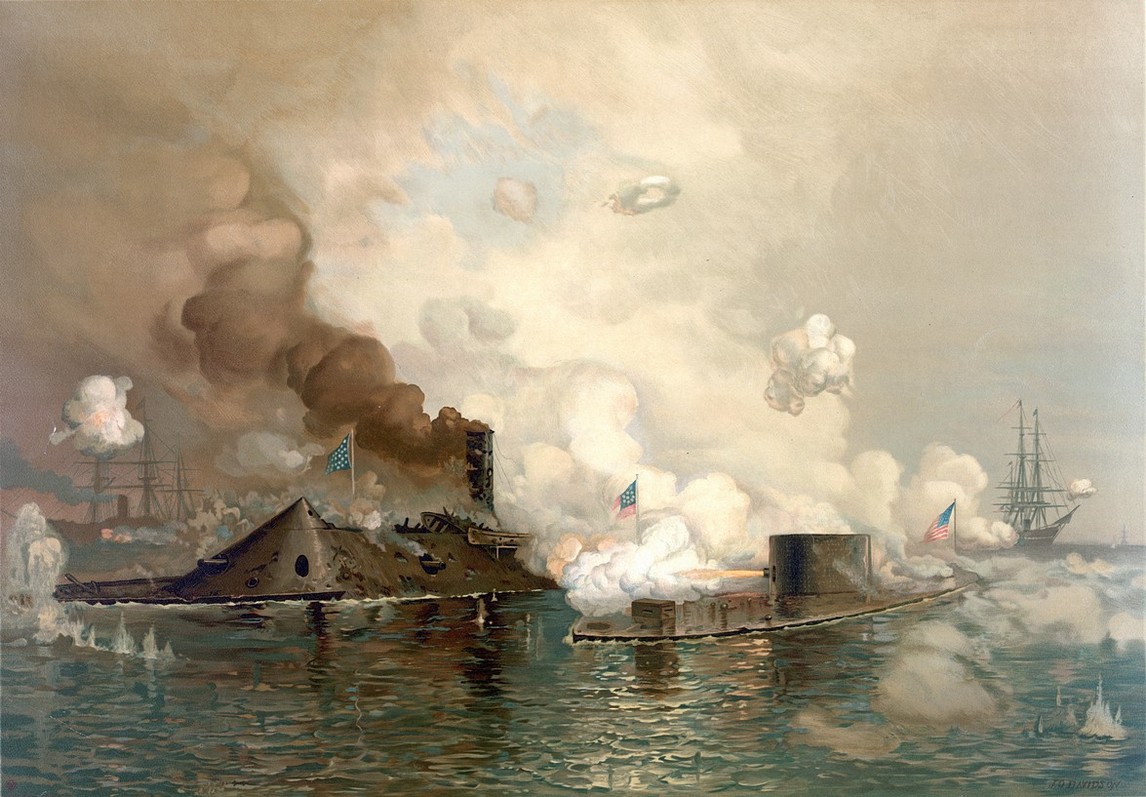
|
| First Battleship Duel in History was Fought between USS Monitor and CSS Virginia on March 9, 1862 |
(Left) CSS Virginia was merely a product of raising and rebuilding
the scuttled USS Merrimack. The Merrimack was a wooden frigate powered by sail and a single steam
engine and was scuttled in 1861 to avoid being captured by the Confederacy. The casemate ironclad CSS Virginia
was powered by two steam engines and single screw. Her casemate had 14 gun ports, three each in the bow and
stern, one firing directly along the ship's centerline, the two others angled at 45° from the center line; these six bow and
stern gun ports had exterior iron shutters installed to project their cannon. There were four gun ports on each broadside;
their protective iron shutters remained uninstalled during both days of the Battle of Hampton Roads. Virginia's battery consisted
of four muzzle-loading single-banded Brooke rifles and six smoothbore 9-inch Dahlgren guns salvaged from the old Merrimack.
Two of the rifles, the bow and stern pivot guns, were 7-inch caliber and weighed 14,500 pounds each. They fired a 104-pound
shell. The other two were 6.4-inch cannon of about 9,100 pounds, one on each broadside. The 9-inch Dahlgrens were mounted
three to a side; each weighed approximately 9,200 pounds and could fire a 72.5-pound shell to a range of 3,357 yards
at an elevation of 15°. The two amidship Dahlgrens nearest the boiler furnaces were fitted-out to fire heated shot. On her
upper casemate deck were positioned two anti-boarding/personnel 12-pounder Howitzers. (Right)
The USS Monitor was an iron-hulled steamship powered by a single steam engine and propeller, and it had a revolving turret
that housed two massive guns. The Monitor was intended to mount a pair of 15-inch smoothbore Dahlgren guns,
but they were not ready in time and 11-inch guns were substituted. Each gun weighed approximately 16,000 pounds. Monitor's
guns used the standard propellant charge of 15 pounds specified by the 1860 ordnance for targets "distant", "near", and "ordinary",
established by the gun's designer Dahlgren himself. They could fire a 136-pound round shot or shell to a distance of
3,650 yards at an elevation of +15°.
| Union and Confederate Navy History |
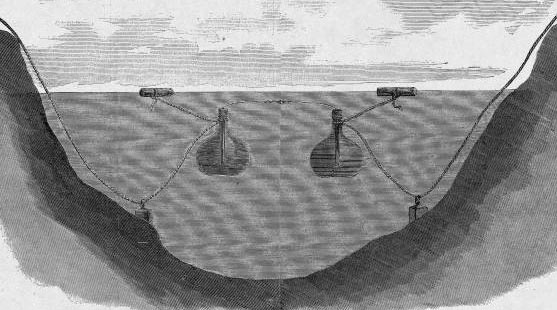
|
| Civil War Navy History |
Battleships
The Battle of Hampton Roads (1862) was the first combat between ironclad warships, the USS Monitor
and the CSS Virginia. The great battleships of the first and second wars were descendants of these two
ironclads. The battle received worldwide attention, and it had immediate effects on navies around the world. The preeminent
naval powers, Great Britain and France, halted further construction of wooden-hulled ships, and others followed suit. A new
type of warship was produced, the monitor, based on the principle of the original. The use of a small number of very heavy
guns, mounted so that they could fire in all directions was first demonstrated by Monitor but soon became standard in warships
of all types. Shipbuilders also incorporated rams into the designs of warship hulls for the remainder of the century.
Torpedo and Mine
(Right) Harpers Weekly, January 1863, illustration of
naval torpedoes moored to the river bottom (the predecessors of modern naval mines).
During the Civil War, the term torpedo was used for what is now known as
the contact mine, floating on or below the water surface using an air-filled demijohn or similar flotation device. These devices
were very primitive, and were apt to prematurely explode. They would be detonated on contact with the ship, or after a set
time, although electrical detonators were also occasionally used. The USS Cairo
was the first warship to be sunk, in 1862, by an electrically detonated mine. A
spar torpedo was a mine attached to a long pole and detonated when the ship carrying it rammed another one. The H. L. Hunley
used one to sink the USS Housatonic on February 17, 1864. The Spar torpedo was an explosive device mounted at the end
of a spar up to 30 feet long projecting forward underwater from the bow of the attacking vessel, which would then ram the
enemy vessel with the explosives. These were used by the Confederate submarine H. L. Hunley to sink the USS Housatonic
although the weapon was apt to cause as much harm to its user as to its target.
Submarine
H. L. Hunley was a submarine of the Confederate Navy that played a small but revolutionary
role in the Civil War. Hunley demonstrated the advantages and the dangers of undersea warfare and was the
first combat submarine to sink a warship. Although Hunley was not completely submerged during her successful attack,
she was lost along with her crew while returning to port.
| Civil War and USS Cairo |
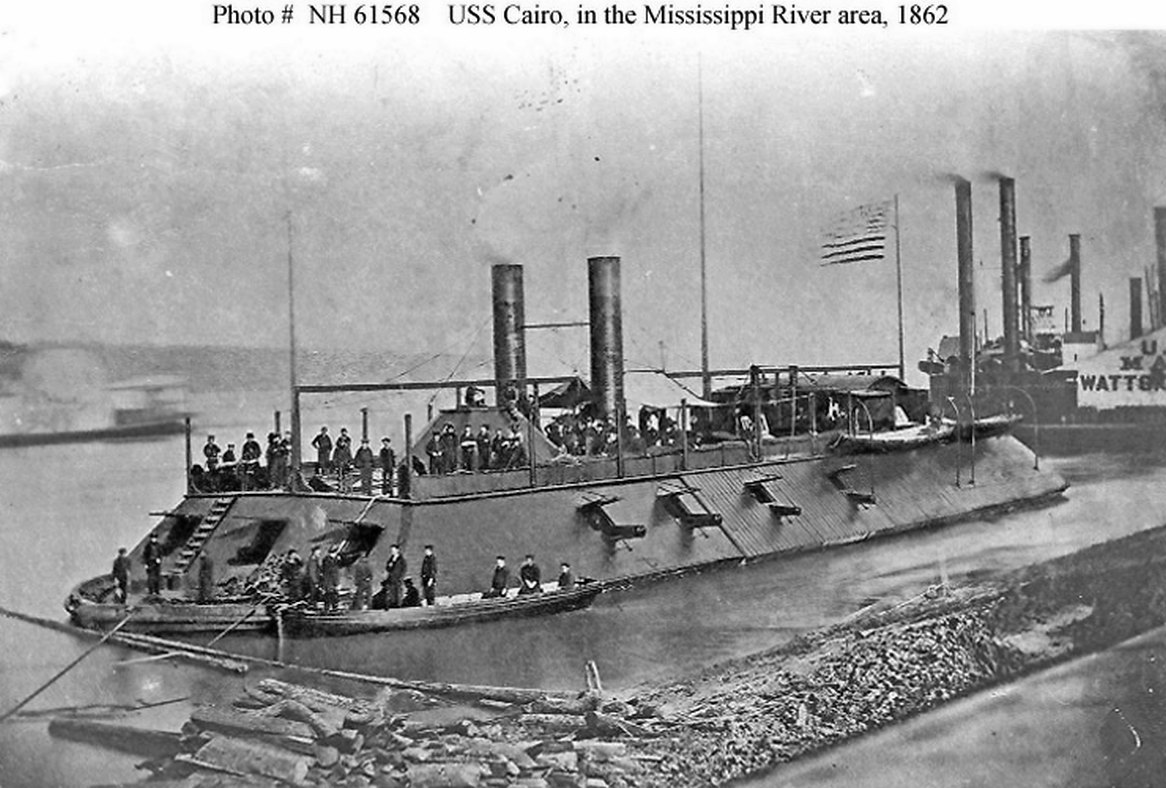
|
| USS Cairo sank after being hit by the first naval mine in warfare history |
On December 12, 1862, while clearing mines from the Yazoo River preparatory
to the attack on Haines Bluff, Mississippi, USS Cairo struck a torpedo detonated by volunteers hidden behind the
river bank and sank in 12 minutes. Although to casualties were reported, the Cairo made history by being the first ship sunk
by a naval mine.
USS Cairo was a steam driven City-class ironclad gunboat constructed
for the Union Navy by James Buchanan Eads during the Civil War. She was the lead ship of the City-class gunboats, also known
as the Cairo class, and was named for Cairo, Illinois. Commissioned on
January 25, 1862, and with a complement of 251 officers and men, the Cairo sank with less than one year service.
Fitted with 16 guns, she was upgraded to 14 more reliable -- less prone to muzzle bursting -- rifled guns in November 1862.
The change removed some of its 42-pounders, which, according to numerous accounts, were known to burst and injure the
crew.
| Union Navy |
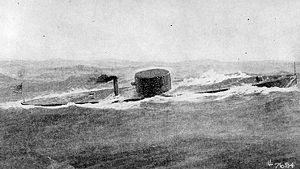
|
| USS Monitor (1862-1862) |
A Complete American Civil War Navy Timeline (Chronology),
with Union and Confederate Naval Battles, Campaigns, Operations, Expeditions, Assaults, Engagements and Bombardments: The
Ironclads and Rams, Gunboats, Raiders, Steamers, Blockaders, Blockade Runners, Blockading Fleets, and Schooners
| Confederate Navy |
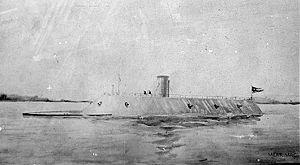
|
| CSS Virginia (1862-1862) (ex-USS Merrimack) |
| Civil War Navy |
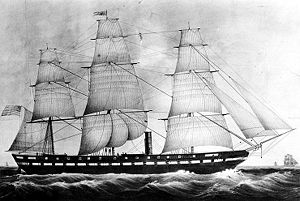
|
| USS Merrimack (1856-1861) (CSS Virginia in 1862) |
(Continued below)
Recommended
Reading: A History of Ironclads: The Power of Iron over Wood. Description: This
landmark book documents the dramatic history of Civil War ironclads and reveals how ironclad warships revolutionized naval
warfare. Author John V. Quarstein explores in depth the impact of ironclads during the Civil War and their colossal effect
on naval history. The Battle of Hampton Roads was one of history's greatest naval engagements. Over the course of two days
in March 1862, this Civil War conflict decided the fate of all the world's navies. It was the first battle between ironclad
warships, and the 25,000 sailors, soldiers and civilians who witnessed the battle vividly understood what history would soon
confirm: wars waged on the seas would never be the same. Continued below…
About the Author: John V. Quarstein is an award-winning author and historian. He is director
of the Virginia
War Museum in Newport News and chief historical advisor for The Mariners' Museum's new USS Monitor Center
(opened March 2007). Quarstein has authored eleven books and dozens of articles on American, military and Civil War history,
and has appeared in documentaries for PBS, BBC, The History Channel and Discovery Channel.
Recommended Reading: Civil
War Navies, 1855-1883 (The U.S. Navy Warship Series) (Hardcover). Description: Civil
War Warships, 1855-1883 is the second in the five-volume US Navy Warships encyclopedia set. This valuable reference lists
the ships of the U.S. Navy and Confederate Navy during the Civil War and the years immediately following - a significant period
in the evolution of warships, the use of steam propulsion, and the development of ordnance. Civil War Warships provides a
wealth and variety of material not found in other books on the subject and will save the reader the effort needed to track
down information in multiple sources. Continued below…
Each ship's
size and time and place of construction are listed along with particulars of naval service. The author provides historical
details that include actions fought, damage sustained, prizes taken, ships sunk, and dates in and out of commission as well
as information about when the ship left the Navy, names used in other services, and its ultimate fate. 140 photographs, including
one of the Confederate cruiser Alabama recently uncovered by the author further contribute to this
indispensable volume. This definitive record of Civil War ships updates the author's previous work and will find a lasting
place among naval reference works.
Recommended Reading: Naval Campaigns of the Civil War. Description: This analysis of naval engagements during the War Between the States presents the action
from the efforts at Fort Sumter during the secession of South Carolina in 1860, through the battles in the Gulf of Mexico,
on the Mississippi River, and along the eastern seaboard, to the final attack at Fort Fisher on the coast of North Carolina
in January 1865. This work provides an understanding of the maritime problems facing both sides at the beginning of the war,
their efforts to overcome these problems, and their attempts, both triumphant and tragic, to control the waterways of the
South. The Union blockade, Confederate privateers and commerce raiders are discussed, as is the famous battle between the
Monitor and the Merrimack. Continued below…
An overview
of the events in the early months preceding the outbreak of the war is presented. The chronological arrangement of the campaigns
allows for ready reference regarding a single event or an entire series of campaigns. Maps and an index are also included.
About the Author: Paul Calore, a graduate of Johnson and Wales University,
was the Operations Branch Chief with the Defense Logistics Agency of the Department of Defense before retiring. He is a supporting
member of the U.S. Civil War Center and the Civil War Preservation Trust and has also written Land Campaigns of the Civil
War (2000). He lives in Seekonk, Massachusetts.
Recommended Reading:
Rebels and Yankees: Naval Battles of the
Civil War (Hardcover). Description: Naval
Battles of the Civil War, written by acclaimed Civil War historian Chester G. Hearn, focuses on the maritime battles fought
between the Confederate Rebels and the Union forces in waters off the eastern seaboard and the great rivers of the United States during the Civil War. Continued below...
Since very few books have been written on this subject, this volume provides a fascinating and vital portrayal
of the one of the most important conflicts in United States history. Naval Battles
of the Civil War is lavishly illustrated with rare contemporary photographs, detailed artworks, and explanatory maps, and
the text is a wonderful blend of technical information, fast-flowing narrative, and informed commentary.
Recommended Reading: A History of the Confederate Navy (Hardcover). From Publishers Weekly: One of the most prominent European scholars of the Civil War weighs
in with a provocative revisionist study of the Confederacy's naval policies. For 27 years, University of Genoa history professor
Luraghi (The Rise and Fall of the Plantation South) explored archival and monographic sources on both sides of the Atlantic
to develop a convincing argument that the deadliest maritime threat to the South was not, as commonly thought, the Union's
blockade but the North's amphibious and river operations. Confederate Navy Secretary Stephen Mallory, the author shows, thus
focused on protecting the Confederacy's inland waterways and controlling the harbors vital for military imports. Continued
below…
As a result,
from Vicksburg
to Savannah to Richmond, major
Confederate ports ultimately were captured from the land and not from the sea, despite the North's overwhelming naval strength.
Luraghi highlights the South's ingenuity in inventing and employing new technologies: the ironclad, the submarine, the torpedo.
He establishes, however, that these innovations were the brainchildren of only a few men, whose work, although brilliant,
couldn't match the resources and might of a major industrial power like the Union. Nor did
the Confederate Navy, weakened through Mallory's administrative inefficiency, compensate with an effective command system.
Enhanced by a translation that retains the verve of the original, Luraghi's study is a notable addition to Civil War maritime
history. Includes numerous photos.
Recommended Reading: Lincoln's Navy: The Ships, Men and Organization, 1861-65 (Hardcover). Review: Naval historian Donald L. Canney provides a good overview of the U.S. Navy during
the Civil War, describing life at sea, weapons, combat, tactics, leaders, and of course, the ships themselves. He reveals
the war as a critical turning point in naval technology, with ironclads (such as the Monitor) demonstrating their superiority
to wooden craft and seaborne guns (such as those developed by John Dahlgren) making important advances. Continued below...
The real reason to own this oversize book, however, is for the images: more than 200 of them, including
dozens of contemporary photographs of the vessels that fought to preserve the Union. There are maps and portraits, too; this fine collection of pictures brings vividness
to its subject that can't be found elsewhere.
Recommended Reading:
Submarine Warfare in the Civil War. Description: Many people have heard of the Hunley,
the experimental Confederate submarine that sank the USS Housatonic in a daring nighttime operation. Less well known, however,
is that the Hunley was not alone under the waters of America
during the Civil War. Both the Union and Confederacy built a wide and incredible array of
vessels that could maneuver underwater, and many were put to use patrolling enemy waters. Continued below...
In Submarine Warfare in the Civil War, Mark Ragan, who spent years mining factory records and log books,
brings this little-known history to the surface. The hardcover edition, Union and Confederate Submarine Warfare in the Civil War, was published to wide acclaim
in 1999. For this new paperback edition, Ragan has revised and updated the text to include the full story of the Hunley's
recovery and restoration.
Recommended Reading: The Rebel Raiders: The Astonishing History of the Confederacy's Secret Navy (American Civil War). From Booklist: DeKay's modest monograph
pulls together four separate stories from the naval aspects of the American Civil War. All have been told before but never
integrated as they are here. The first story is that of James Bulloch, the Confederate agent who carefully and capably set
out to have Confederate commerce raiders built in neutral England.
The second is that of the anti-American attitudes of British politicians, far more extreme than conventional histories let
on, and U.S. Ambassador Charles Francis Adams' heroic fight against them. The third is a thoroughly readable narrative of
the raider Alabama and her capable, quirky captain, Raphael
Semmes. The final story is about the Alabama claims--suits for damages done to the U.S. merchant marine by Confederate raiders, which became
the first successful case of international arbitration. Sound and remarkably free of fury, DeKay's commendable effort nicely
expands coverage of the naval aspects of the Civil War.
Recommended Reading: The Confederate Navy in Europe. Description: The Confederate Navy in Europe
is an account of the Confederate officers and officials who went on missions to Britain
and France to buy ships for the CS Navy,
and to support CSN operations on the high seas, such as commerce raiding. Spencer tells the story of how some officers rose
to the occasion (some did not) and did a lot with limited resources. Continued below...
The majority of the ships ordered never reached America. Shipbuilding takes time, and
as the war dragged on the European powers were persuaded by Confederate battlefield misfortunes and US diplomatic pressure that it was most expedient to deny the sales of such innovative
designs as ocean-going ironclads. Like other out-manned and out-gunned powers, the CSA did have to resort to ingenuity and
innovation.
Recommended Reading:
Naval Strategies of the Civil War: Confederate
Innovations and Federal Opportunism. Description:
One of the most overlooked aspects of the American Civil War is the naval strategy played out by the U.S. Navy and the fledgling
Confederate Navy, which may make this the first book to compare and contrast the strategic concepts of the Southern Secretary
of the Navy Stephen R. Mallory against his Northern counterpart, Gideon Welles. Both men had to accomplish much and were given
great latitude in achieving their goals. Mallory's vision of seapower emphasized technological innovation and individual competence
as he sought to match quality against the Union Navy's (quantity) numerical superiority. Welles had to deal with more bureaucratic
structure and to some degree a national strategy dictated by the White House. Continued below...
The naval blockade
of the South was one of his first tasks - for which he had but few ships available - and although he followed the national
strategy, he did not limit himself to it when opportunities arose. Mallory's dedication to ironclads is well known, but he
also defined the roles of commerce raiders, submarines, and naval mines. Welles's contributions to the Union effort were rooted
in his organizational skills and his willingness to cooperate with the other military departments of his government. This
led to successes through combined army and naval units in several campaigns on and around the Mississippi River.
Recommended Reading: Lincoln and His Admirals (Hardcover). Description: Abraham Lincoln began his presidency admitting that he knew "little about ships,"
but he quickly came to preside over the largest national armada to that time, not eclipsed until World War I. Written by prize-winning
historian Craig L. Symonds, Lincoln and His Admirals unveils an aspect of Lincoln's presidency unexamined by historians until
now, revealing how he managed the men who ran the naval side of the Civil War, and how the activities of the Union Navy ultimately
affected the course of history. Continued below…
Beginning with
a gripping account of the attempt to re-supply Fort Sumter--a comedy of errors that shows
all too clearly the fledgling president's inexperience--Symonds traces Lincoln's
steady growth as a wartime commander-in-chief. Absent a Secretary of Defense, he would eventually become de facto commander
of joint operations along the coast and on the rivers. That involved dealing with the men who ran the Navy: the loyal but
often cranky Navy Secretary Gideon Welles, the quiet and reliable David G. Farragut, the flamboyant and unpredictable Charles
Wilkes, the ambitious ordnance expert John Dahlgren, the well-connected Samuel Phillips Lee, and the self-promoting and gregarious
David Dixon Porter. Lincoln was remarkably patient; he often
postponed critical decisions until the momentum of events made the consequences of those decisions evident. But Symonds also
shows that Lincoln could act decisively. Disappointed by the
lethargy of his senior naval officers on the scene, he stepped in and personally directed an amphibious assault on the Virginia coast, a successful operation that led to the capture of Norfolk.
The man who knew "little about ships" had transformed himself into one of the greatest naval strategists of his age. A unique
and riveting portrait of Lincoln and the admirals under his command, this book offers an illuminating account of Lincoln and the nation at war. In the bicentennial year of Lincoln's birth, it offers a memorable portrait of a side of his presidency
often overlooked by historians.
|

